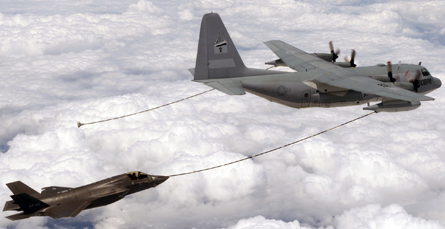The F-35 Lightning II is making good progress through flight testing this year, a top Lockheed Martin official says. Most of the biggest challenges faced by the programme should be well on their way to being fixed by the later part of the year.
One major issue that has recently popped up on the US Navy's F-35C variant is that the aircraft's tail-hook has had to be redesigned. That is because the existing design has failed to catch an arresting cable during trials. Lockheed is working on a new improved hook design that should fix the problem.
"We have modified the hook pointwith a lower center of gravity," says Steve O'Bryan, Lockheed's vice president for F-35 programme integration and business development. Additionally, "we've redesigned the hold-down damper."
 |
|---|
©Lockheed Martin |
The new design is scheduled for its preliminary design review in "the summer." That will be followed by a critical design review in the fourth quarter.
After the new hook design undergoes shore-based qualification trails, the F-35C will undergo sea trials on a carrier in late 2013 or early 2014.
Lockheed is also set to test fixes to the jet's troublesome helmet-mounted display (HMD) this summer, O'Bryan says. Lockheed has reached an agreement with the US government on the HMD requirements, which will help the company to fix imagery lag on the helmet by tweaking the system's software, he says.
The company is also adding micro inertial measurement units (IMU) to the helmet and pilot's seat to dampen out jittery images. "We're going to fly those micro-IMUs this summer," O'Bryan says.
Lockheed hopes that the new ISIE-11 camera, which replaces the existing ISIE-10 cameras, will resolve jet's night vision acuity problems. The new system will undergo testing at MIT's Lincoln Labs later this summer. The system will now consist of two ISIE-11 cameras, one of which will be mounted in the helmet and another on the canopy bow, and imagery pumped in from the F-35's six distributed aperture system (DAS) infrared cameras.
"We're optimistic, we've got a good plan," O'Bryan says.
Meanwhile, the pilots have started to test the imagery from the distributed aperture system. Initial results look to be very promising, O'Bryan says. But there will need to be tweaks as flight tests reveal potential issues.
Other avionics tests are proceeding well. The F-35 has already started testing the Link-16 data-link and will soon start to test the variable message format link which is needed for the close air support mission. There are also ongoing tests with the radar, electronic warfare, and infrared targeting system, which are needed for the release of the Block 2A training software.
On the flight sciences side, the US Marine Corps short take-off vertical landing (STOVL) F-35B test programme is further along than that of the F-35C. The previously troubled B-model is now running 20% ahead of this year's planned test schedule, O'Bryan says.
The F-35B has flown at altitudes over 49,000ft and has hits speeds of Mach 1.4. That's just shy of the F-35's required 50, 000 ft ceiling and Mach 1.6 design speed limit, he says. The B-model has also flown at its maximum airspeed of 630 knots and has achieved its maximum 7G limit.
"It's about over 50% complete with its clean-wing full-envelop test points," O'Byan says.
 |
|---|
©Lockheed Martin |
The F-35C is also about 20% ahead of this year's flight test plan, O'Bryan says. Like the F-35B, the C-model has flown out to 630 knots, but the naval variant is required to hit 700 knots. The C-model has also flown at 45, 000 ft and at speeds of Mach 1.4. It has also hit its maximum 7.5G limit.
That means the USN version has completed about 40% of its clean configuration flight envelope test points, O'Bryan says.
Out at Edwards AFB, California, F-35A will have completed 45% of the totality of its flight test points by the end of the year. By the fourth quarter, the F-35A should have competed its first full lifetime of durability testing, O'Bryan says. There have thus far been no new issues that have arisen as a result of the tests.
'That, I'm happy to say, is going well," he says.
The all versions of the jet have started flying with external stores. Later this year, the aircraft will enter into high angle of attack testing, which will ultimate hit 50angle of attack, O'Bryan says. The programme will also start wet runway tests, engine air starts, and weapons releases.
Source: Flight International























